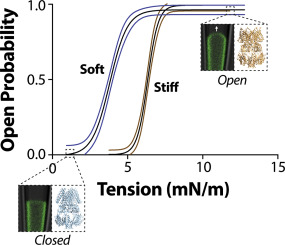当前位置:
X-MOL 学术
›
BBA Biomembr.
›
论文详情
Our official English website, www.x-mol.net, welcomes your
feedback! (Note: you will need to create a separate account there.)
Membrane stiffness is one of the key determinants of E. coli MscS channel mechanosensitivity.
Biochimica et Biophysica Acta (BBA) - Biomembranes ( IF 2.8 ) Pub Date : 2020-01-22 , DOI: 10.1016/j.bbamem.2020.183203 Feng Xue 1 , Charles D Cox 2 , Navid Bavi 3 , Paul R Rohde 1 , Yoshitaka Nakayama 2 , Boris Martinac 2
Biochimica et Biophysica Acta (BBA) - Biomembranes ( IF 2.8 ) Pub Date : 2020-01-22 , DOI: 10.1016/j.bbamem.2020.183203 Feng Xue 1 , Charles D Cox 2 , Navid Bavi 3 , Paul R Rohde 1 , Yoshitaka Nakayama 2 , Boris Martinac 2
Affiliation

|
Mechanosensitive (MS) channels have an intimate relationship with membrane lipids that underlie their mechanosensitivity. Membrane lipids may influence channel activity by directly interacting with MS channels or by influencing the global properties of the membrane such as elastic area expansion modulus or bending rigidity. Previous work has implicated membrane stiffness as a potential determinant of the mechanosensitivity of E. coli (Ec)MscS. Here we systematically tested this hypothesis using patch fluorometry of azolectin liposomes doped with lipids of increasing elastic area expansion modulus. Increasing dioleoylphosphatidylethanolamine (DOPE) content of azolectin liposomes made it more difficult to activate EcMscS by membrane tension (i.e. increased gating threshold). This effect was exacerbated by stiffer forms of phosphatidylethanolamine such as the branched chain lipid diphytanoylphosphoethanolamine (DPhPE) or the fully saturated lipid distearoyl-sn-glycero-3-phosphoethanolamine (DSPE). Furthermore, a comparison of the branched chain lipid diphytanoylphosphocholine (DPhPC) to the stiffer DPhPE indicated again that it was harder to activate EcMscS in the presence of the stiffer DPhPE. We show that these effects are not due to changes in membrane bending rigidity as the membrane tension threshold of EcMscS in membranes doped with PC18:1 and PC18:3 remained the same, despite a two-fold difference in their bending rigidity. We also show that after prolonged pressure application sudden removal of force in softer membranes caused a rebound reactivation of EcMscS and we discuss the relevance of this phenomenon to bacterial osmoregulation. Collectively, our data suggests that membrane stiffness (elastic area expansion modulus) is one of the key determinants of the mechanosensitivity of EcMscS.
中文翻译:

膜刚度是大肠杆菌MscS通道机械敏感性的关键决定因素之一。
机械敏感(MS)通道与作为其机械敏感度基础的膜脂有密切关系。膜脂可通过与MS通道直接相互作用或通过影响膜的整体特性(例如弹性面积膨胀模量或弯曲刚度)来影响通道活性。先前的工作暗示膜硬度是大肠杆菌(Ec)MscS的机械敏感性的潜在决定因素。在这里,我们使用掺有增加弹性面积扩展模量的脂质的唑他汀脂质体的荧光贴片荧光法系统地检验了这一假设。唑他汀脂质体中的油酰磷脂酰乙醇胺(DOPE)含量增加,使得通过膜张力(即增加门控阈值)激活EcMscS更加困难。刚性形式的磷脂酰乙醇胺(例如支链脂质二植烷酰基磷酸乙醇胺(DPhPE)或完全饱和的脂质二硬脂酰基-sn-甘油-3-磷酸乙醇胺(DSPE))会加剧这种效应。此外,支链脂质二植烷酰基磷酸胆碱(DPhPC)与较硬的DPhPE的比较再次表明,在较硬的DPhPE的存在下,很难激活EcMscS。我们表明,这些影响不是由于膜弯曲刚度的变化所致,因为PC18:1和PC18:3掺杂的膜中EcMscS的膜张力阈值保持不变,尽管它们的弯曲刚度有两倍差异。我们还表明,长时间施加压力后,在较软的膜上突然消除作用力会导致EcMscS的反弹重新激活,因此我们讨论了该现象与细菌渗透压的相关性。总的来说,我们的数据表明,膜的刚度(弹性面积膨胀模量)是EcMscS机械敏感性的关键决定因素之一。
更新日期:2020-01-22
中文翻译:

膜刚度是大肠杆菌MscS通道机械敏感性的关键决定因素之一。
机械敏感(MS)通道与作为其机械敏感度基础的膜脂有密切关系。膜脂可通过与MS通道直接相互作用或通过影响膜的整体特性(例如弹性面积膨胀模量或弯曲刚度)来影响通道活性。先前的工作暗示膜硬度是大肠杆菌(Ec)MscS的机械敏感性的潜在决定因素。在这里,我们使用掺有增加弹性面积扩展模量的脂质的唑他汀脂质体的荧光贴片荧光法系统地检验了这一假设。唑他汀脂质体中的油酰磷脂酰乙醇胺(DOPE)含量增加,使得通过膜张力(即增加门控阈值)激活EcMscS更加困难。刚性形式的磷脂酰乙醇胺(例如支链脂质二植烷酰基磷酸乙醇胺(DPhPE)或完全饱和的脂质二硬脂酰基-sn-甘油-3-磷酸乙醇胺(DSPE))会加剧这种效应。此外,支链脂质二植烷酰基磷酸胆碱(DPhPC)与较硬的DPhPE的比较再次表明,在较硬的DPhPE的存在下,很难激活EcMscS。我们表明,这些影响不是由于膜弯曲刚度的变化所致,因为PC18:1和PC18:3掺杂的膜中EcMscS的膜张力阈值保持不变,尽管它们的弯曲刚度有两倍差异。我们还表明,长时间施加压力后,在较软的膜上突然消除作用力会导致EcMscS的反弹重新激活,因此我们讨论了该现象与细菌渗透压的相关性。总的来说,我们的数据表明,膜的刚度(弹性面积膨胀模量)是EcMscS机械敏感性的关键决定因素之一。











































 京公网安备 11010802027423号
京公网安备 11010802027423号